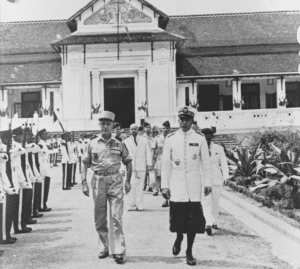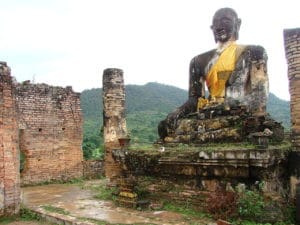
In 1960, amidst a series of rebellions in the Kingdom of Laos, fighting broke out between the RLA and the communist North Vietnamese and Soviet Union-backed Pathet Lao guerillas. A second Provisional Government of National Unity formed by Prince Souvanna Phouma in 1962 was unsuccessful, and the situation steadily deteriorated into large scale civil war between the Royal Laotian government and the Pathet Lao. The Pathet Lao were backed militarily by the People’s Army of Vietnam (PAVN) and Vietcong.
Laos was a key part of the Vietnam War since parts of Laos were invaded and occupied by North Vietnam for use as a supply route for its war against South Vietnam. In response, the United States initiated a bombing campaign against the PAVN positions, supported regular and irregular anticommunist forces in Laos and supported Army of the Republic of Vietnam incursions into Laos.
In 1968 the PAVN launched a multi-division attack to help the Pathet Lao to fight the RLA. The attack resulted in the RLA largely demobilizing, leaving the conflict to irregular ethnic Hmong forces of the “Secret Army” backed by the United States and Thailand, and led by General Vang Pao.
Massive aerial bombardment against the PAVN/Pathet Lao forces were carried out by the United States to prevent the collapse of the Kingdom of Laos central government, and to deny the use of the Ho Chi Minh Trail to attack US forces in South Vietnam. Between 1964 and 1973, the U.S. dropped two million tons of bombs on Laos, nearly equal to the 2.1 million tons of bombs the U.S. dropped on Europe and Asia during all of World War II, making Laos the most heavily bombed country in history relative to the size of its population; The New York Times noted this was “nearly a ton for every person in Laos”.

Some 80 million bombs failed to explode and remain scattered throughout the country, rendering vast swathes of land impossible to cultivate and killing or maiming approximately 50 Laotians every year. Due to the particularly heavy impact of cluster bombs during this war, Laos was a strong advocate of the Convention on Cluster Munitions to ban the weapons, and was host to the First Meeting of States Parties to the convention in November 2010.
In 1975 the Pathet Lao overthrew the royalist government, forcing King Savang Vatthana to abdicate on 2 December 1975. He later died under suspicious circumstances in a re-education camp. Between 20,000 and 62,000 Laotians died during the Civil War.
On 2 December 1975, after taking control of the country, the Pathet Lao government under Kaysone Phomvihane renamed the country as the Lao People’s Democratic Republic and signed agreements giving Vietnam the right to station armed forces and to appoint advisers to assist in overseeing the country. The close ties between Laos and Vietnam were formalized via a treaty signed in 1977, which has since provided not only directions for Lao foreign policy, but also the basis for Vietnamese involvement at all levels of Lao political and economic life. Laos was requested in 1979 by Vietnam to end relations with the People’s Republic of China, leading to isolation in trade by China, the United States, and other countries. In 1979 there were 50,000 PAVN troops stationed in Laos and as many as 6,000 civilian Vietnamese officials including 1,000 directly attached to the ministries in Vientiane.
